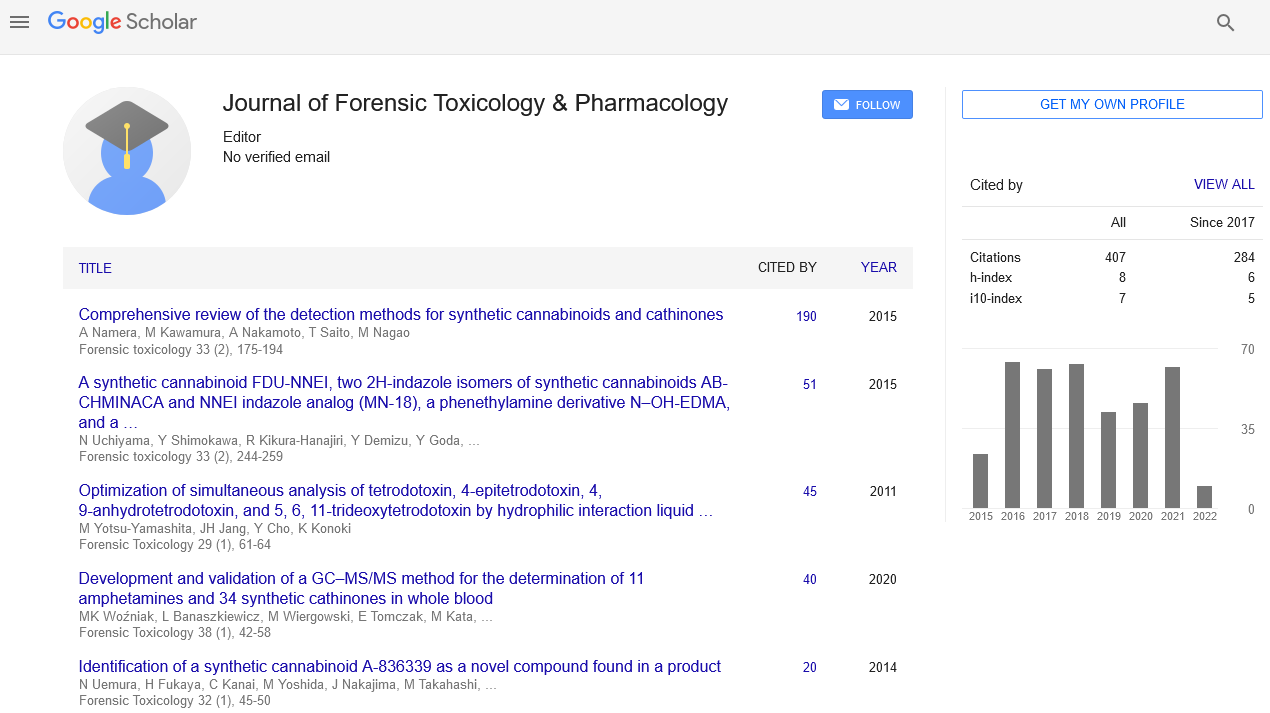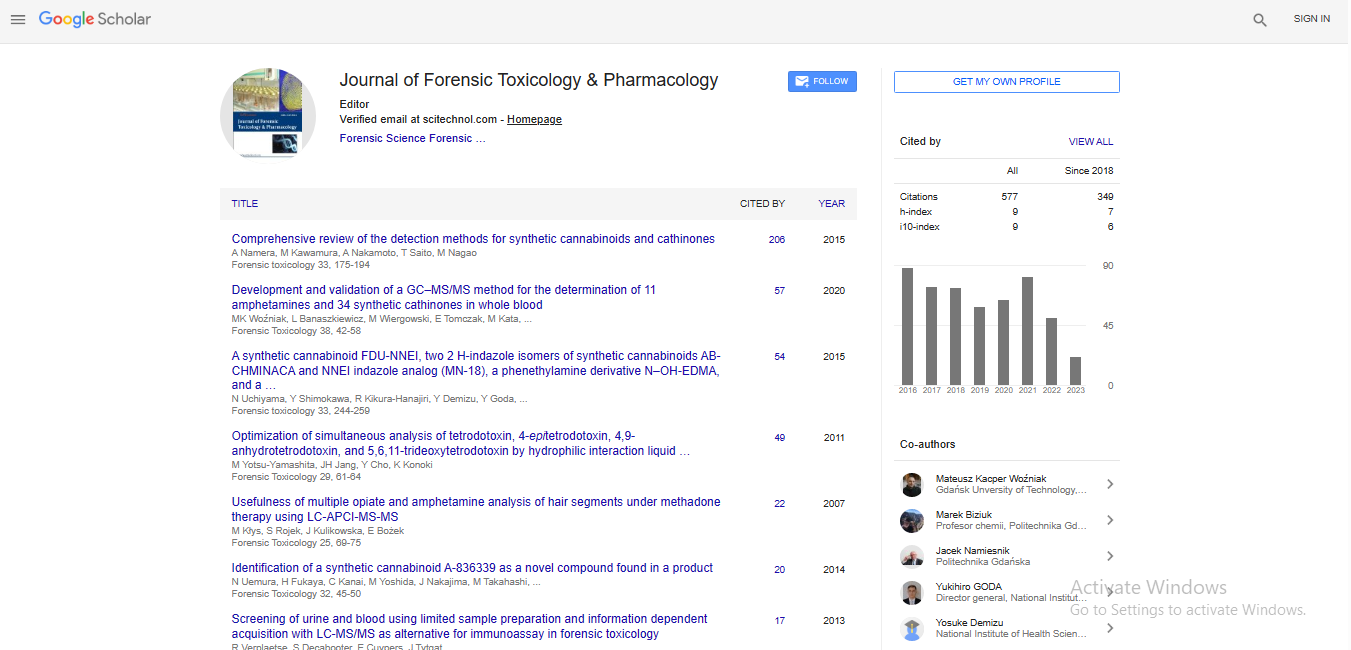Opinion Article, J Forensic Toxicol Pharmacol Vol: 13 Issue: 4
Mechanisms and Effects of Chronic Toxicity in Humans
Cassandra Baker*
1Department of Computer and Information Systems, Islamic University of Madinah, Saudi Arabia
*Corresponding Author: Cassandra Baker,
Department of Computer and Information Systems, Islamic University of Madinah,
Saudi Arabia
E-mail: bakercassandra@gmail.com
Received date: 26 November, 2024, Manuscript No. JFTP-24-156288;
Editor assigned date: 28 November, 2024, PreQC No. JFTP-24-156288 (PQ);
Reviewed date: 12 December, 2024, QC No JFTP-24-156288
Revised date: 19 December, 2024, Manuscript No. JFTP-24-156288 (R);
Published date: 26 December, 2024, DOI: 10.4172/JFTP.1000208.
Citation: Baker C (2024) Mechanisms and Effects of Chronic Toxicity in Humans. J Forensic Toxicol Pharmacol 13:4.
Keywords: Department of Computer and Information Systems, Islamic University of Madinah, Saudi Arabi
Description
Chronic toxicity refers to the adverse effects that result from prolonged exposure to a toxic substance over an extended period, often at low doses. Unlike acute toxicity, which manifests rapidly, chronic toxicity develops insidiously, with symptoms that may only become apparent after weeks, months, or even years of continuous exposure. Understanding the mechanisms and effects of chronic toxicity is essential for safeguarding public health and developing effective prevention and intervention strategies.
The mechanisms underlying chronic toxicity are diverse and depend on the nature of the toxicant, the exposure route and individual susceptibility. One common mechanism involves bioaccumulation, where toxic substances gradually build up in the body due to their persistence and poor elimination. Heavy metals like lead, mercury and cadmium are notorious for their bioaccumulative properties. These metals interfere with enzymatic functions, disrupt cellular signaling, and induce oxidative stress, leading to long-term organ damage.
Oxidative stress is a key contributor to chronic toxicity. It occurs when an imbalance arises between the production of Reactive Oxygen Species (ROS) and the body’s antioxidant defenses. Persistent oxidative stress damages cellular components such as DNA, proteins, and lipids, resulting in chronic inflammation and an increased risk of diseases such as cancer, neurodegenerative disorders, and cardiovascular conditions. For instance, prolonged exposure to benzene, a chemical found in industrial settings, has been linked to oxidative DNA damage and leukemia.
Endocrine disruption is another significant mechanism of chronic toxicity. Certain toxicants, known as Endocrine-Disrupting Chemicals (EDCs), mimic or interfere with hormonal signaling pathways. These substances, including pesticides like DDT and industrial compounds such as Bisphenol A (BPA), can alter reproductive function, thyroid activity, and metabolic processes. Long-term exposure to EDCs has been associated with developmental abnormalities, infertility, and hormonal cancers.
Chronic toxicity also often involves epigenetic modifications, which are changes in gene expression without alterations to the DNA sequence. Toxicants such as arsenic and tobacco smoke can induce epigenetic changes, including DNA methylation and histone modification, which may persist across generations. These modifications can influence susceptibility to diseases, contributing to the long-term health impacts of chronic exposure.
The effects of chronic toxicity are far-reaching, impacting virtually every organ system. The liver and kidneys, being primary sites of detoxification, are particularly vulnerable. Chronic exposure to substances like alcohol or aflatoxins can lead to liver cirrhosis or hepatocellular carcinoma. Similarly, nephrotoxins such as cadmium and certain medications can cause chronic kidney disease.
Neurological effects are also prevalent in chronic toxicity. Neurotoxicants such as lead and organophosphates impair cognitive function, motor skills, and sensory processing. In children, chronic lead exposure can result in irreversible intellectual and developmental deficits, underscoring the need for stringent regulatory measures.
Respiratory effects are commonly observed in individuals exposed to airborne toxicants such as asbestos and silica dust. Prolonged inhalation of these substances can cause chronic respiratory diseases, including asbestosis, silicosis and lung cancer. Occupational settings with inadequate protective measures often pose significant risks for such exposures.
The cardiovascular system is another target of chronic toxicity. Persistent exposure to toxicants such as arsenic and air pollutants has been linked to hypertension, atherosclerosis, and an increased risk of heart attacks. These effects are often mediated by inflammation, oxidative stress and endothelial dysfunction.
Chronic toxicity also has implications for public health, with economic and social consequences. The burden of chronic diseases attributed to toxic exposures includes increased healthcare costs, reduced workforce productivity, and diminished quality of life. Preventive measures, such as reducing environmental pollution, implementing occupational safety protocols and promoting public awareness, are essential to reduce these impacts.
Scientific advancements are enhancing our understanding of chronic toxicity and its prevention. Biomonitoring programs, which measure the levels of toxicants in biological samples, provide valuable insights into exposure trends and risk factors. Moreover, the development of predictive toxicology tools, such as in silico models and high-throughput screening assays, facilitates the identification of potentially harmful substances before widespread exposure occurs.
Chronic toxicity represents a significant public health challenge, driven by complex mechanisms such as bioaccumulation, oxidative stress, endocrine disruption and epigenetic changes. Its effects are pervasive, affecting multiple organ systems and contributing to a broad spectrum of diseases. By advancing our understanding of these processes and implementing proactive measures, society can better protect individuals from the insidious impacts of chronic toxicant exposure.
 Spanish
Spanish  Chinese
Chinese  Russian
Russian  German
German  French
French  Japanese
Japanese  Portuguese
Portuguese  Hindi
Hindi 
